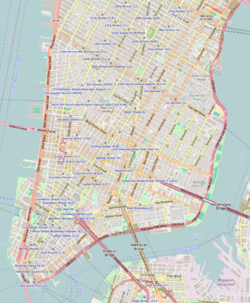 The Angel Orensanz Center, housed within a former synagogue | |
Location in Lower Manhattan | |
Former names | Ansche Chesed Conregation |
|---|---|
| Established | 1986 |
| Location | 172-176 Norfolk Street, Lower East Side, Manhattan, New York City, New York 10002 |
| Coordinates | 40°43′16″N 73°59′09″W / 40.72111°N 73.98583°W |
| Type | Art gallery and performance space |
| Founder | Angel Orensanz |
| Owner | Angel Orensanz Foundation |
| Website | orensanz |
| Architect | Alexander Saeltzer |
| Architectural style(s) | Gothic Revival |
| Designated | June 14, 1983 |
| Reference no. | 1440 |
The Angel Orensanz Center is an art and performance space at 172 Norfolk Street, between Stanton Street and East Houston Street, on the Lower East Side of Manhattan in New York City. It was originally built as a synagogue, running through a succession of congregations and continues to be used as one occasionally as The Shul of New York.[1]
It was erected in 1849, making it the oldest surviving synagogue building in New York City,[2] and the fourth-oldest surviving synagogue building in the United States.[3] It was the largest synagogue in the United States at the time of its construction and is one of the few built in the Gothic Revival style.[4][5][6]
From 1849 to 1974, at various stages, the building has been used as a synagogue.[7][8][9] and then, following vandalism, acquired by the government of New York City (1981), after which it was sold to a succession of owners: Hungarian Development, Inc. (1983), Seashells, Inc. (1984), and finally Angel Lopez Orensanz (1986).[10] Spanish sculptor and painter Angel Orensanz purchased the property in 1986, about after 12 years after its last synagogue-owners had abandoned its use. He restored it and converted it into an art gallery and performance space known as the Angel Orensanz Foundation Center for the Arts. The New York City Landmarks Preservation Commission designated the building as a historic landmark the following year. It subsequently became home to The Shul of New York, a liberal non-denominational synagogue.[7]: 15
- ^ Kurshan, Virginia (February 10, 1987). "Anshe Slonim Synagogue (original Anshe Chesed Synagogue), 172–176 Norfolk Street, Borough of Manhattan. Built 1849–1850; architect Alexander Saeltzer; Landmark Site: Tax Map Block 355, Lot 41" (PDF). New York City Landmarks Preservation Commission. Retrieved December 10, 2023.
- ^ "Angel Orensanz Foundation". Atlas Obscura. Retrieved October 15, 2022.
- ^ Gordon, Mark W. "Rediscovering Jewish Infrastructure: 2022 Update on United States Eighteenth and Nineteenth-Century Synagogues", American Jewish Historical Society, November 4, 2021. Accessed February 22, 2023.
- ^ Weissman Joselit, Jenna (September 2008). "History: The Symbol that Split the Synagogue". Reform Judaism Magazine. Archived from the original on September 28, 2011. Retrieved October 10, 2011.
- ^ Cite error: The named reference
google1was invoked but never defined (see the help page). - ^ Fodor's 2003 New York City. Fodor's Travel Publications. 2002. ISBN 1-4000-1036-5. Retrieved October 10, 2011.
- ^ a b Dunlap, David W. (2004). From Abyssinian to Zion: a guide to Manhattan's houses of worship. Columbia University Press. ISBN 9780231125420. Retrieved October 10, 2011 – via Google Books.
- ^ Cite error: The named reference
Dunlap1987was invoked but never defined (see the help page). - ^ "Search results | npc.mayfirst.org". neighborhoodpreservationcenter.org. Retrieved August 23, 2015.
- ^ "New York City Dept. of Finance Digital Tax Map". NYC.gov. Retrieved July 8, 2019.
